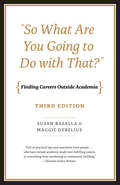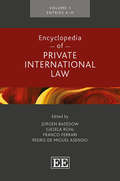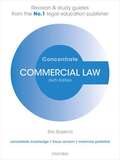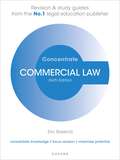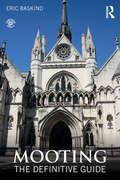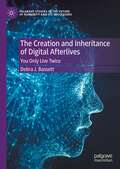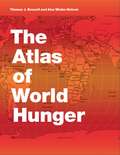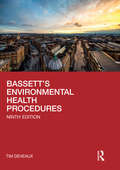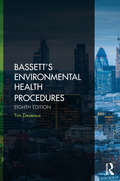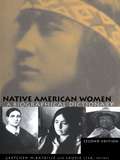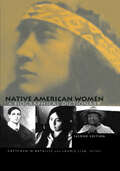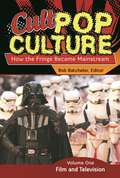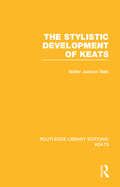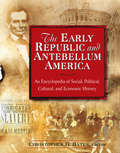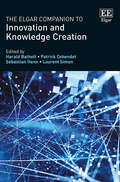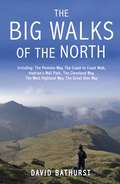- Table View
- List View
"So What Are You Going to Do with That?": Finding Careers Outside Academia, Third Edition
by Susan Basalla Maggie DebeliusGraduate schools churn out tens of thousands of PhDs and MAs every year. Yet more than half of all college courses are taught by adjunct faculty, which means that the chances of an academic landing a tenure-track job seem only to shrink as student loan and credit card debts grow. What’s a frustrated would-be scholar to do? Can she really leave academia? Can a job outside the academy really be rewarding? And could anyone want to hire a grad-school refugee? In this third edition of “So What Are You Going to Do with That?”, thoroughly revised with new advice for students in the sciences, Susan Basalla and Maggie Debelius—PhDs themselves—answer all those questions with a resounding “Yes!” A witty, accessible guide full of concrete advice for anyone contemplating the jump from scholarship to the outside world, “So What Are You Going to Do with That?” covers topics ranging from career counseling to interview etiquette to how to translate skills learned in the academy into terms an employer can understand and appreciate. Packed with examples and stories from real people who have successfully made this daunting—but potentially rewarding—transition, and written with a deep understanding of both the joys and difficulties of the academic life, this fully updated guide will be indispensable for any graduate student or professor who has ever glanced at his or her CV, flipped through the want ads, and wondered, “What if?”
"So What Are You Going to Do with That?": Finding Careers Outside Academia, Third Edition
by Susan Basalla Maggie DebeliusGraduate schools churn out tens of thousands of PhDs and MAs every year. Yet more than half of all college courses are taught by adjunct faculty, which means that the chances of an academic landing a tenure-track job seem only to shrink as student loan and credit card debts grow. What’s a frustrated would-be scholar to do? Can she really leave academia? Can a job outside the academy really be rewarding? And could anyone want to hire a grad-school refugee? In this third edition of “So What Are You Going to Do with That?”, thoroughly revised with new advice for students in the sciences, Susan Basalla and Maggie Debelius—PhDs themselves—answer all those questions with a resounding “Yes!” A witty, accessible guide full of concrete advice for anyone contemplating the jump from scholarship to the outside world, “So What Are You Going to Do with That?” covers topics ranging from career counseling to interview etiquette to how to translate skills learned in the academy into terms an employer can understand and appreciate. Packed with examples and stories from real people who have successfully made this daunting—but potentially rewarding—transition, and written with a deep understanding of both the joys and difficulties of the academic life, this fully updated guide will be indispensable for any graduate student or professor who has ever glanced at his or her CV, flipped through the want ads, and wondered, “What if?”
"So What Are You Going to Do with That?": Finding Careers Outside Academia, Third Edition
by Susan Basalla Maggie DebeliusGraduate schools churn out tens of thousands of PhDs and MAs every year. Yet more than half of all college courses are taught by adjunct faculty, which means that the chances of an academic landing a tenure-track job seem only to shrink as student loan and credit card debts grow. What’s a frustrated would-be scholar to do? Can she really leave academia? Can a job outside the academy really be rewarding? And could anyone want to hire a grad-school refugee? In this third edition of “So What Are You Going to Do with That?”, thoroughly revised with new advice for students in the sciences, Susan Basalla and Maggie Debelius—PhDs themselves—answer all those questions with a resounding “Yes!” A witty, accessible guide full of concrete advice for anyone contemplating the jump from scholarship to the outside world, “So What Are You Going to Do with That?” covers topics ranging from career counseling to interview etiquette to how to translate skills learned in the academy into terms an employer can understand and appreciate. Packed with examples and stories from real people who have successfully made this daunting—but potentially rewarding—transition, and written with a deep understanding of both the joys and difficulties of the academic life, this fully updated guide will be indispensable for any graduate student or professor who has ever glanced at his or her CV, flipped through the want ads, and wondered, “What if?”
Encyclopedia of Private International Law
by Jürgen Basedow Franco Ferrari Giesela Rühl Pedro De Miguel AsensioThe Encyclopedia of Private International Law quite simply represents the definitive reference work in the field. Bringing together 195 authors from 57 countries the Encyclopedia sheds light on the current state of Private International Law around the globe, providing unique insights into the discipline and how it is affected by globalization and increased regional integration. The role and character of Private International Law has changed tremendously over the past decades. With the steady increase of global and regional inter-connectedness the practical significance of the discipline has grown. And so has the number of legislative activities on the national, international and, most importantly, the European level. The Encyclopedia is a rich and varied resource in four volumes. The first two volumes provide comprehensive coverage of topical aspects of Private International Law in the form of 247 alphabetically arranged entries. The third volume provides insightful detail on the national Private International Law regimes of 80 different countries. The fourth volume presents invaluable, and often unique, English language translations of the national codifications and provisions of Private International Law in those countries. Key Features: • 247 substantive entries • 80 national reports • Entries organized alphabetically for ease of navigation • Fully cross-referenced • Entries written by the world’s foremost scholars of Private International Law • National codifications in English collected together into a single volume for quick reference • World class editor team.
Mooting: The Definitive Guide
by Eric BaskindMooting offers an excellent opportunity to develop your skills in an enjoyable, interactive and challenging way. Participation in mooting can lead to improved academic performance, enhancing your knowledge and your ability to handle complex legal materials as well as improving the power of your persuasive argument and vital skills, which will enhance your profile for prospective employers. In this book, Eric Baskind provides a seamless and comprehensive examination of the various areas involved in mooting and advocacy, combining both theoretical and practical aspects as well as the organisation of and participation in mooting competitions. Online video footage of an actual moot brings the practical nature of mooting alive and will give you expert advice and analysis of successful mooting technique as well as tips for improvement. Each moot video is highlighted at various points of interest to provide expert commentary and analysis of the mooters’ presentation, identifying the mooters’ strengths and weaknesses and how successfully they use cases and other materials to support their argument. These sections will then be re-enacted, incorporating the suggestions for improvements to help you to see how the overall performance could have been improved. This definitive guide will equip you with a complete grasp of mooting from the initial preparatory stages through to advocacy in the moot itself.
Mooting: The Definitive Guide
by Eric BaskindMooting offers an excellent opportunity to develop your skills in an enjoyable, interactive and challenging way. Participation in mooting can lead to improved academic performance, enhancing your knowledge and your ability to handle complex legal materials as well as improving the power of your persuasive argument and vital skills, which will enhance your profile for prospective employers. In this book, Eric Baskind provides a seamless and comprehensive examination of the various areas involved in mooting and advocacy, combining both theoretical and practical aspects as well as the organisation of and participation in mooting competitions. Online video footage of an actual moot brings the practical nature of mooting alive and will give you expert advice and analysis of successful mooting technique as well as tips for improvement. Each moot video is highlighted at various points of interest to provide expert commentary and analysis of the mooters’ presentation, identifying the mooters’ strengths and weaknesses and how successfully they use cases and other materials to support their argument. These sections will then be re-enacted, incorporating the suggestions for improvements to help you to see how the overall performance could have been improved. This definitive guide will equip you with a complete grasp of mooting from the initial preparatory stages through to advocacy in the moot itself.
The Creation and Inheritance of Digital Afterlives: You Only Live Twice (Palgrave Studies in the Future of Humanity and its Successors)
by Debra J. BassettThis book explores how social networking platforms such as Facebook, Twitter, and WhatsApp ‘accidentally’ enable and nurture the creation of digital afterlives, and, importantly, the effect this digital inheritance has on the bereaved. Debra J. Bassett offers a holistic exploration of this phenomenon and presents qualitative data from three groups of participants: service providers, digital creators, and digital inheritors. For the bereaved, loss of data, lack of control, or digital obsolescence can lead to a second loss, and this book introduces the theory of ‘the fear of second loss’. Bassett argues that digital afterlives challenge and disrupt existing grief theories, suggesting how these theories might be expanded to accommodate digital inheritance. This interdisciplinary book will be of interest to sociologists, cyber psychologists, philosophers, death scholars, and grief counsellors. But Bassett’s book can also be seen as a canary in the coal mine for the ‘intentional’ Digital Afterlife Industry (DAI) and their race to monetise the dead. This book provides an understanding of the profound effects uncontrollable timed posthumous messages and the creation of thanabots could have on the bereaved, and Bassett’s conception of a Digital Do Not Reanimate (DDNR) order and a voluntary code of conduct could provide a useful addition to the DAI. Even in the digital societies of the West, we are far from immortal, but perhaps the question we really need to ask is: who wants to live forever?
The Atlas of World Hunger
by Thomas J. Bassett Alex Winter-NelsonEarlier this year, President Obama declared one of his top priorities to be “making sure that people are able to get enough to eat.” The United States spends about five billion dollars on food aid and related programs each year, but still, both domestically and internationally, millions of people are hungry. In 2006, the Food and Agricultural Organization of the United Nations counted 850 million hungry people worldwide, but as food prices soared, an additional 100 million or more who were vulnerable succumbed to food insecurity. If hunger were simply a matter of food production, no one would go without. There is more than enough food produced annually to provide every living person with a healthy diet, yet so many suffer from food shortages, unsafe water, and malnutrition every year. That’s because hunger is a complex political, economic, and ecological phenomenon. The interplay of these forces produces a geography of hunger that Thomas J. Bassett and Alex Winter-Nelson illuminate in this empowering book. The Atlas of World Hunger uses a conceptual framework informed by geography and agricultural economics to present a hunger index that combines food availability, household access, and nutritional outcomes into a single tool—one that delivers a fuller understanding of the scope of global hunger, its underlying mechanisms, and the ways in which the goals for ending hunger can be achieved. The first depiction of the geography of hunger worldwide, the Atlas will be an important resource for teachers, students, and anyone else interested in understanding the geography and causes of hunger. This knowledge, the authors argue, is a critical first step toward eliminating unnecessary suffering in a world of plenty.
The Atlas of World Hunger
by Thomas J. Bassett Alex Winter-NelsonEarlier this year, President Obama declared one of his top priorities to be “making sure that people are able to get enough to eat.” The United States spends about five billion dollars on food aid and related programs each year, but still, both domestically and internationally, millions of people are hungry. In 2006, the Food and Agricultural Organization of the United Nations counted 850 million hungry people worldwide, but as food prices soared, an additional 100 million or more who were vulnerable succumbed to food insecurity. If hunger were simply a matter of food production, no one would go without. There is more than enough food produced annually to provide every living person with a healthy diet, yet so many suffer from food shortages, unsafe water, and malnutrition every year. That’s because hunger is a complex political, economic, and ecological phenomenon. The interplay of these forces produces a geography of hunger that Thomas J. Bassett and Alex Winter-Nelson illuminate in this empowering book. The Atlas of World Hunger uses a conceptual framework informed by geography and agricultural economics to present a hunger index that combines food availability, household access, and nutritional outcomes into a single tool—one that delivers a fuller understanding of the scope of global hunger, its underlying mechanisms, and the ways in which the goals for ending hunger can be achieved. The first depiction of the geography of hunger worldwide, the Atlas will be an important resource for teachers, students, and anyone else interested in understanding the geography and causes of hunger. This knowledge, the authors argue, is a critical first step toward eliminating unnecessary suffering in a world of plenty.
Bassett's Environmental Health Procedures
by W.H. Bassett Tim DeveauxEnvironmental health law is a wide-ranging, detailed and complex body of law within the UK. Bassett’s Environmental Health Procedures is an established and essential reference source which provides an accessible entry into enforcement and administrative procedures for environmental health. The main legal procedures used in the environmental health field are presented as flow charts supported by explanatory text. This ninth edition refines the structure introduced in the eighth edition, with each chapter addressing a single topic. It has introduced the titles of the corresponding legislation in Scotland and Northern Ireland where there is such legislation. The book has been updated throughout to reflect new practices, legislation and statutory guidance. Specifically, the ninth edition contains new content on Antisocial Behaviour and significant updates to sections on: Enforcement and Administration Environmental Protection Food Safety Housing and Public Health Environmental Health Officers/Practitioners and students will find this book invaluable. It will also be an essential reference for all those whose responsibilities demand they keep abreast of current environmental health practices.
Bassett's Environmental Health Procedures
by W.H. Bassett Tim DeveauxEnvironmental health law is a wide-ranging, detailed and complex body of law within the UK. Bassett’s Environmental Health Procedures is an established and essential reference source which provides an accessible entry into enforcement and administrative procedures for environmental health. The main legal procedures used in the environmental health field are presented as flow charts supported by explanatory text. This ninth edition refines the structure introduced in the eighth edition, with each chapter addressing a single topic. It has introduced the titles of the corresponding legislation in Scotland and Northern Ireland where there is such legislation. The book has been updated throughout to reflect new practices, legislation and statutory guidance. Specifically, the ninth edition contains new content on Antisocial Behaviour and significant updates to sections on: Enforcement and Administration Environmental Protection Food Safety Housing and Public Health Environmental Health Officers/Practitioners and students will find this book invaluable. It will also be an essential reference for all those whose responsibilities demand they keep abreast of current environmental health practices.
Bassett's Environmental Health Procedures
by W.H. Bassett Tim DeveauxEnvironmental health law is a wide-ranging, detailed and complex body of law within the UK. Environmental Health Procedures is an established and essential reference source which provides an accessible entry into enforcement and administrative procedures for environmental health. The main legal procedures used in the environmental health field are presented as flow charts supported by explanatory text. The structure of this eighth edition has been revised for ease of use, with each chapter now addressing a single topic instead of a piece of legislation. It also introduces legal guidance for environmental health practitioners to prepare them for the court prosecutions that are an essential part of their work. The book has been updated throughout to reflect new practices, legislation and statutory guidance including: Primary Authorities Authorisations for public water supplies Infectious disease control Port Health RIDDOR Environmental permitting Environmental damage Imported food Empty homes Licensing of housing Licensing of gambling activities Environmental Health Officers/Practitioners and students will find this book invaluable. It will also be an essential reference for all those whose responsibilities demand they keep abreast of current environmental health practices.
Bassett's Environmental Health Procedures
by W.H. Bassett Tim DeveauxEnvironmental health law is a wide-ranging, detailed and complex body of law within the UK. Environmental Health Procedures is an established and essential reference source which provides an accessible entry into enforcement and administrative procedures for environmental health. The main legal procedures used in the environmental health field are presented as flow charts supported by explanatory text. The structure of this eighth edition has been revised for ease of use, with each chapter now addressing a single topic instead of a piece of legislation. It also introduces legal guidance for environmental health practitioners to prepare them for the court prosecutions that are an essential part of their work. The book has been updated throughout to reflect new practices, legislation and statutory guidance including: Primary Authorities Authorisations for public water supplies Infectious disease control Port Health RIDDOR Environmental permitting Environmental damage Imported food Empty homes Licensing of housing Licensing of gambling activities Environmental Health Officers/Practitioners and students will find this book invaluable. It will also be an essential reference for all those whose responsibilities demand they keep abreast of current environmental health practices.
Native American Women: A Biographical Dictionary (Biographical Dictionaries of Minority Women)
by Gretchen M. Bataille Laurie LisaThis A-Z reference contains 275 biographical entries on Native American women, past and present, from many different walks of life. Written by more than 70 contributors, most of whom are leading American Indian historians, the entries examine the complex and diverse roles of Native American women in contemporary and traditional cultures. This new edition contains 32 new entries and updated end-of-article bibliographies. Appendices list entries by area of woman's specialization, state of birth, and tribe; also includes photos and a comprehensive index.
Native American Women: A Biographical Dictionary (Biographical Dictionaries of Minority Women)
by Gretchen M. Bataille Laurie LisaThis A-Z reference contains 275 biographical entries on Native American women, past and present, from many different walks of life. Written by more than 70 contributors, most of whom are leading American Indian historians, the entries examine the complex and diverse roles of Native American women in contemporary and traditional cultures. This new edition contains 32 new entries and updated end-of-article bibliographies. Appendices list entries by area of woman's specialization, state of birth, and tribe; also includes photos and a comprehensive index.
Cult Pop Culture [3 volumes]: How the Fringe Became Mainstream [3 volumes]
by Bob. BatchelorThis three-volume collection of original essays examines cult pop culture, the often-seedy underbelly of American popular culture.Cult Pop Culture: How the Fringe Became Mainstream is the first collection dedicated to the quirky, offbeat aspects of American popular culture that people have loved, enjoyed, (and in some cases) worshiped over the last 50 years. By examining the people and subjects we hold most dear, this three-volume set offers deep insights into what Americans think, feel, and cherish.Organized by subject, the collection enables readers to focus on a given topic or compare different subjects across cult phenomenon. Volume One of the set covers film and television topics, Volume Two examines music and literature, and Volume Three explores sports, clubs, and the cult industry. Through this investigation of sublime, transcendent, and idiosyncratic trends, readers will learn more about iconic individuals, topics, and subjects that form the vast underbelly of American culture. By revealing how tightly interwoven cult topics are with the public's broader notion of popular culture, the collection underscores the blurry line between normal and abnormal, grandiose and degradation.
The Stylistic Development of Keats (Routledge Library Editions: Keats)
by Walter Jackson BateThis study, first published in 1945, gives a precise description of the unfolding of a great poet’s craftsmanship and suggests alignments of the technical progression with the changes of the mind. Metrical analysis is given in order to throw light on Keats’ general stylistic development using the simplest terminology and in a traditional manner. Earlier English prosodic writings are referred to throughout in order to place the style and development in the context of the period. Arranged chronologically, each chapter looks at a particular work or group of works drawing together evidence about Keats’ poetic direction. This classic work from a well-known Keats scholar is an important enlightening contribution within the extensive study of Keats’ poetry and letters.
The Stylistic Development of Keats (Routledge Library Editions: Keats)
by Walter Jackson BateThis study, first published in 1945, gives a precise description of the unfolding of a great poet’s craftsmanship and suggests alignments of the technical progression with the changes of the mind. Metrical analysis is given in order to throw light on Keats’ general stylistic development using the simplest terminology and in a traditional manner. Earlier English prosodic writings are referred to throughout in order to place the style and development in the context of the period. Arranged chronologically, each chapter looks at a particular work or group of works drawing together evidence about Keats’ poetic direction. This classic work from a well-known Keats scholar is an important enlightening contribution within the extensive study of Keats’ poetry and letters.
The Early Republic and Antebellum America: An Encyclopedia of Social, Political, Cultural, and Economic History
by Christopher G. BatesFirst Published in 2015. This text holds four volumes of essays and entries on the early Republic and Antebellum era in America spanning the end of the American Revolution in 1781 to the outbreak of Civil War in 1861. The Americans forged a new government in theory and then in practice, with the beginnings of industrialisation and the effects of urbanisation, widespread poverty, labour strife, debates around slavery and sectional discord. By the end of the nineteenth century American had a powerhouse economy, new technologies and the emergence of major social reform movements, creation of uniquely American art and literature and the conquest of the West. This encyclopaedia offers a historic reference.
The Early Republic and Antebellum America: An Encyclopedia of Social, Political, Cultural, and Economic History
by Christopher G. BatesFirst Published in 2015. This text holds four volumes of essays and entries on the early Republic and Antebellum era in America spanning the end of the American Revolution in 1781 to the outbreak of Civil War in 1861. The Americans forged a new government in theory and then in practice, with the beginnings of industrialisation and the effects of urbanisation, widespread poverty, labour strife, debates around slavery and sectional discord. By the end of the nineteenth century American had a powerhouse economy, new technologies and the emergence of major social reform movements, creation of uniquely American art and literature and the conquest of the West. This encyclopaedia offers a historic reference.
The Elgar Companion to Innovation and Knowledge Creation: A Multi-disciplinary Approach (Elgar Original Reference Ser.)
by Harald Bathelt Patrick Cohendet Sebastian Henn Laurent SimonThis Companion provides a comprehensive, state-of-the-art overview and critical evaluation of existing conceptualizations and new developments in innovation research. Arguing that innovation research requires inter- and trans-disciplinary explanations and methodological pluralism at various levels, it draws on multiple perspectives of innovation, knowledge and creativity from economics, geography, history, management, political science and sociology. The Companion provides the definitive guide to the field and introduces new approaches, perspectives and developments. The Companion systematically analyzes the challenges, problems and gaps in innovation research. Leading scholars reflect upon and critically assess the fundamental topics of the field, including: • innovation as a concept • innovation and institutions • innovation and creativity • innovation, networking and communities • innovation in permanent spatial settings • innovation in temporary and virtual settings • innovation, entrepreneurship and market making • innovation governance and management. Innovation researchers and students in economics, economic geography, industrial sociology, innovation studies, international business, management and political science will find the Companion to be an essential resource. It will also appeal to practitioners in innovation and policy makers in economic development, public policy and innovation policy.
The Big Walks of the North
by David BathurstDavid Bathurst has unlaced his boots to produce this definitive companion to the ten best-loved long-distance footpaths in the north of Britain, with each split into manageable sections. Combining detailed descriptions with an appreciation of the beauty and history of the British countryside, this in an indispensable guide for all walkers.
